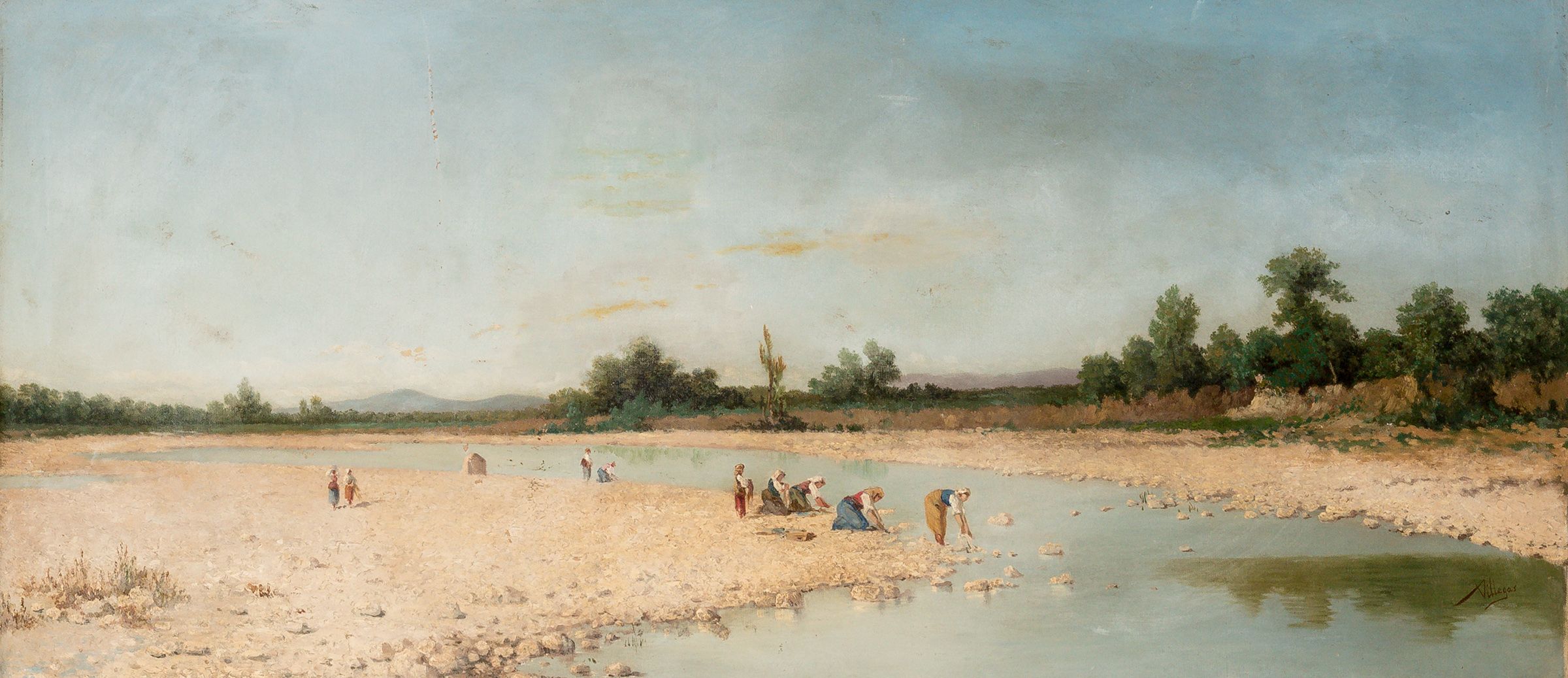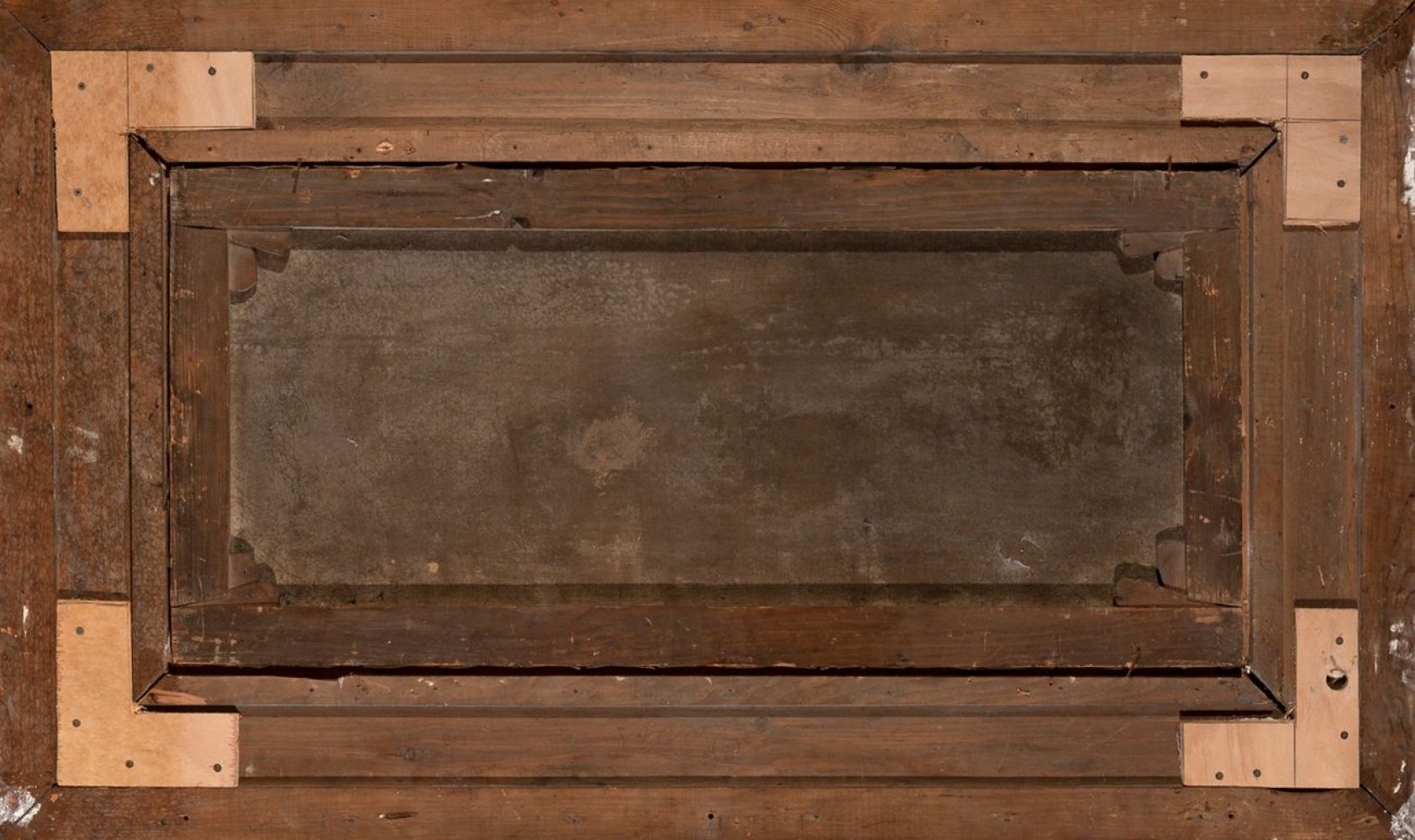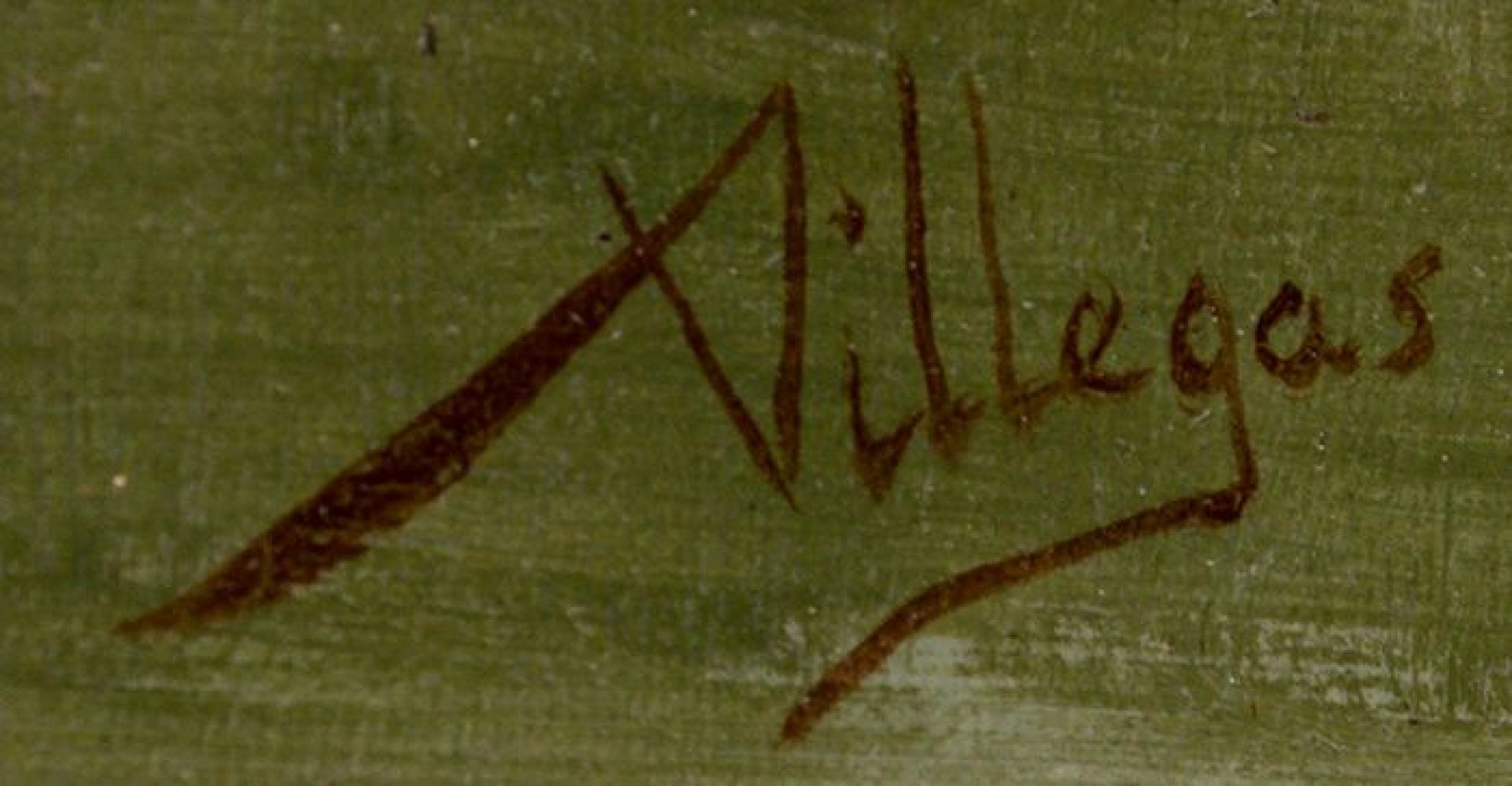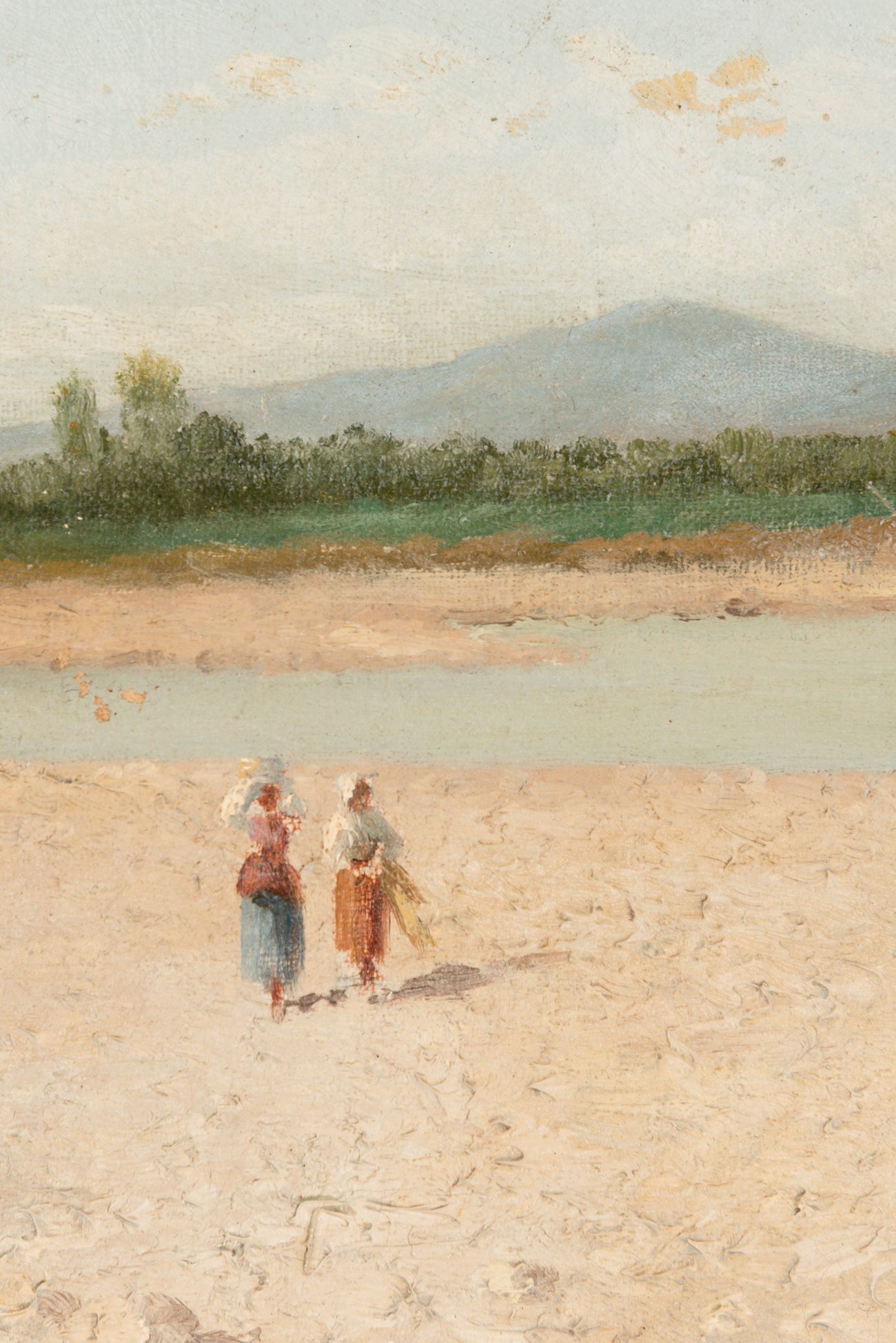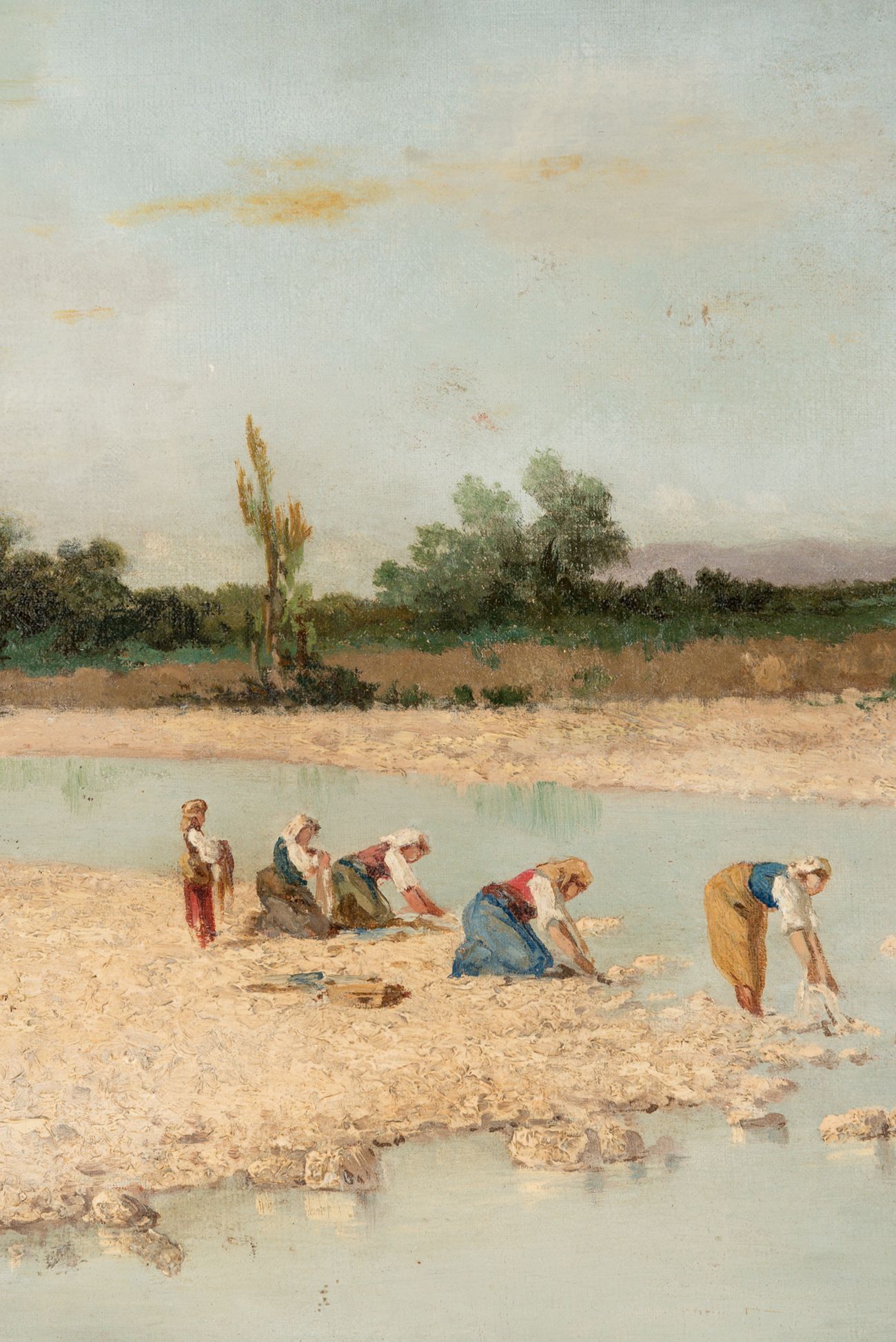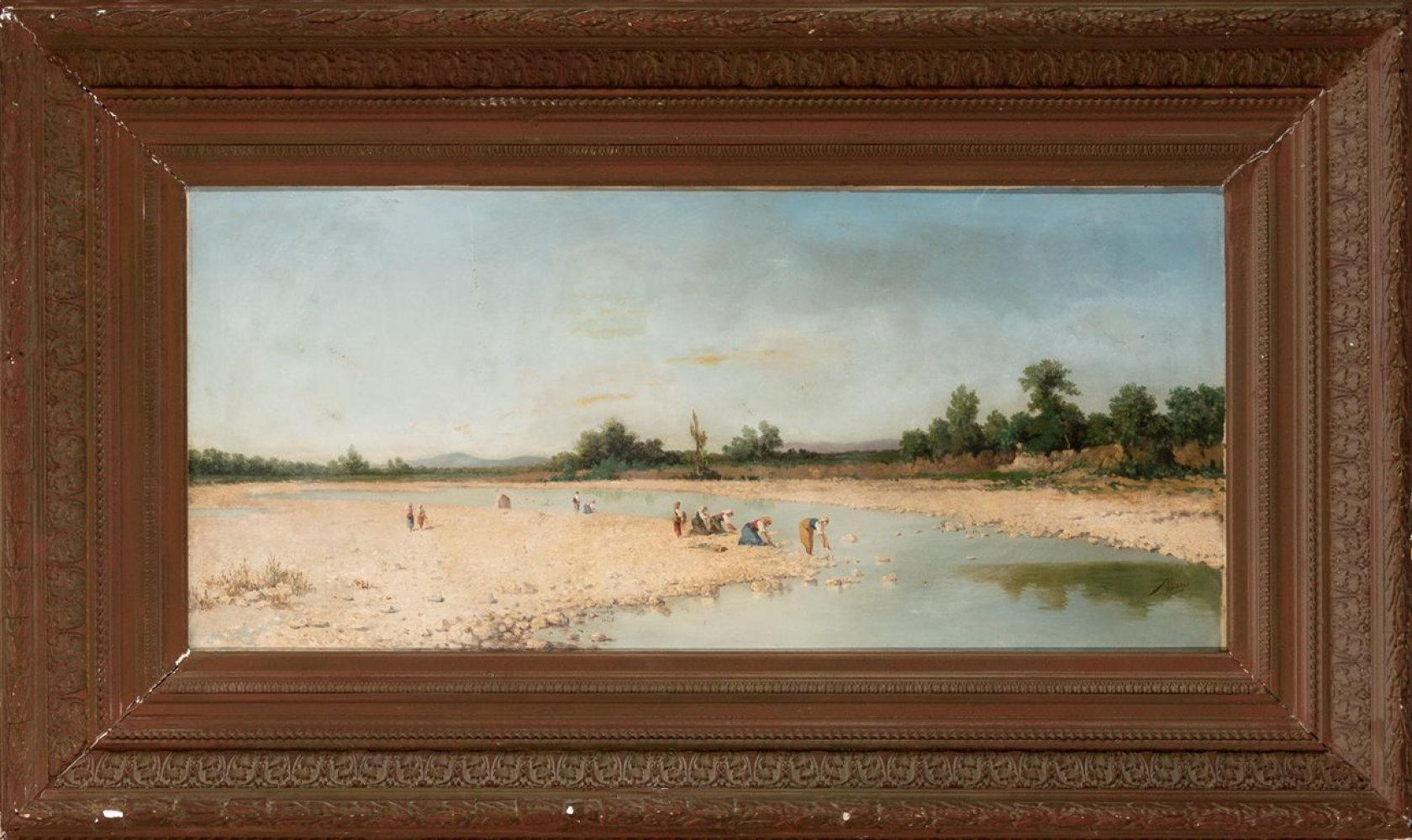15
JOSE VILLEGAS CORDERO (Seville, 1848 - Madrid, 1921).Untitled.Oil on canvas.Attached certificate
1/6
Description
JOSE VILLEGAS CORDERO (Seville, 1848 - Madrid, 1921).
Untitled.
Oil on canvas.
Attached certificate issued by Don Ángel Castro.
It presents slight repainting and damages in the frame.
Measurements: 46 x 99 cm; 80 x 133 cm (frame).
José Villegas began his apprenticeship with José María Romero, under whose guidance he studied for two years. He then entered the School of Fine Arts, where he was a disciple of Eduardo Cano. At an early age he took his painting "Little Philosopher" to the Seville Exhibition of 1860, which sold for 2,000 reales. Around 1867, still in his formative years, he painted two canvases: "Girls begging for alms", highly praised by the critics, and "Columbus at La Rábida", acquired by the Duke and Duchess of Montpensier. He then travelled to Madrid, where he went to the studio of Federico de Madrazo. There he made friends with Rosales and Fortuny, and studied the masters of the Prado Museum. During this period he copied Velázquez, whose spontaneous style he adopted for his pictorial technique, as well as his vibrant colour. Seduced by Fortuny's orientalist work, Villegas returned to Seville and visited Morocco, from where he brought back some sketches and sketches. At the end of 1868 he decided to move to Rome in the company of Rafael Peralta and Luis Jiménez Aranda. There he attended the evening classes at the Accademia Chigi and shared a studio with other colleagues until he moved to Rosales's studio. At this time his work focused on genre scenes, a genre in which Villegas achieved resounding success, being in constant demand by a clientele eager for traditional themes, especially bullfighters and dancers. His extraordinary versatility also enabled him to satisfy the demand of an international clientele who, after Fortuny, demanded Arab fantasy themes. Thus, Villegas made use of his sketches taken in Morocco, without forgetting genre and "casacones" themes. In the mid-1970s he returned to Seville and visited Morocco again. Back in Rome in 1876, he took up the torch left by Fortuny and became the most admired and sought-after painter among dealers and collectors. He continued to work on his orientalist and costumbrist themes and sent his works to Spanish exhibitions. In 1878, following a commission from the Spanish Senate, Villegas began to work on history themes. In the mid-1980s he also focused on paintings directly inspired by Italian Renaissance art, the culminating work in this style being "The Triumph of the Dogaressa", painted in 1892 and exhibited to great acclaim in Berlin. During these years he worked especially in Venice, a city that offered him an inexhaustible setting for his compositions. In 1898 he was appointed director of the Academy of Fine Arts in Rome, in 1901 director of the Museo del Prado and in 1903 a member of the Academy of San Fernando. He is currently represented in the Prado Museum, the Fine Arts Museums of Seville and Cordoba, the San Telmo Museum in San Sebastián and the Bank of Spain Collection, among other important public and private institutions.
Untitled.
Oil on canvas.
Attached certificate issued by Don Ángel Castro.
It presents slight repainting and damages in the frame.
Measurements: 46 x 99 cm; 80 x 133 cm (frame).
José Villegas began his apprenticeship with José María Romero, under whose guidance he studied for two years. He then entered the School of Fine Arts, where he was a disciple of Eduardo Cano. At an early age he took his painting "Little Philosopher" to the Seville Exhibition of 1860, which sold for 2,000 reales. Around 1867, still in his formative years, he painted two canvases: "Girls begging for alms", highly praised by the critics, and "Columbus at La Rábida", acquired by the Duke and Duchess of Montpensier. He then travelled to Madrid, where he went to the studio of Federico de Madrazo. There he made friends with Rosales and Fortuny, and studied the masters of the Prado Museum. During this period he copied Velázquez, whose spontaneous style he adopted for his pictorial technique, as well as his vibrant colour. Seduced by Fortuny's orientalist work, Villegas returned to Seville and visited Morocco, from where he brought back some sketches and sketches. At the end of 1868 he decided to move to Rome in the company of Rafael Peralta and Luis Jiménez Aranda. There he attended the evening classes at the Accademia Chigi and shared a studio with other colleagues until he moved to Rosales's studio. At this time his work focused on genre scenes, a genre in which Villegas achieved resounding success, being in constant demand by a clientele eager for traditional themes, especially bullfighters and dancers. His extraordinary versatility also enabled him to satisfy the demand of an international clientele who, after Fortuny, demanded Arab fantasy themes. Thus, Villegas made use of his sketches taken in Morocco, without forgetting genre and "casacones" themes. In the mid-1970s he returned to Seville and visited Morocco again. Back in Rome in 1876, he took up the torch left by Fortuny and became the most admired and sought-after painter among dealers and collectors. He continued to work on his orientalist and costumbrist themes and sent his works to Spanish exhibitions. In 1878, following a commission from the Spanish Senate, Villegas began to work on history themes. In the mid-1980s he also focused on paintings directly inspired by Italian Renaissance art, the culminating work in this style being "The Triumph of the Dogaressa", painted in 1892 and exhibited to great acclaim in Berlin. During these years he worked especially in Venice, a city that offered him an inexhaustible setting for his compositions. In 1898 he was appointed director of the Academy of Fine Arts in Rome, in 1901 director of the Museo del Prado and in 1903 a member of the Academy of San Fernando. He is currently represented in the Prado Museum, the Fine Arts Museums of Seville and Cordoba, the San Telmo Museum in San Sebastián and the Bank of Spain Collection, among other important public and private institutions.
Auction Details
Shipping
T&Cs & Important Info
Ask seller a question
JOSE VILLEGAS CORDERO (Seville, 1848 - Madrid, 1921).
Untitled.
Oil on canvas.
Attached certificate issued by Don Ángel Castro.
It presents slight repainting and damages in the frame.
Measurements: 46 x 99 cm; 80 x 133 cm (frame).
José Villegas began his apprenticeship with José María Romero, under whose guidance he studied for two years. He then entered the School of Fine Arts, where he was a disciple of Eduardo Cano. At an early age he took his painting "Little Philosopher" to the Seville Exhibition of 1860, which sold for 2,000 reales. Around 1867, still in his formative years, he painted two canvases: "Girls begging for alms", highly praised by the critics, and "Columbus at La Rábida", acquired by the Duke and Duchess of Montpensier. He then travelled to Madrid, where he went to the studio of Federico de Madrazo. There he made friends with Rosales and Fortuny, and studied the masters of the Prado Museum. During this period he copied Velázquez, whose spontaneous style he adopted for his pictorial technique, as well as his vibrant colour. Seduced by Fortuny's orientalist work, Villegas returned to Seville and visited Morocco, from where he brought back some sketches and sketches. At the end of 1868 he decided to move to Rome in the company of Rafael Peralta and Luis Jiménez Aranda. There he attended the evening classes at the Accademia Chigi and shared a studio with other colleagues until he moved to Rosales's studio. At this time his work focused on genre scenes, a genre in which Villegas achieved resounding success, being in constant demand by a clientele eager for traditional themes, especially bullfighters and dancers. His extraordinary versatility also enabled him to satisfy the demand of an international clientele who, after Fortuny, demanded Arab fantasy themes. Thus, Villegas made use of his sketches taken in Morocco, without forgetting genre and "casacones" themes. In the mid-1970s he returned to Seville and visited Morocco again. Back in Rome in 1876, he took up the torch left by Fortuny and became the most admired and sought-after painter among dealers and collectors. He continued to work on his orientalist and costumbrist themes and sent his works to Spanish exhibitions. In 1878, following a commission from the Spanish Senate, Villegas began to work on history themes. In the mid-1980s he also focused on paintings directly inspired by Italian Renaissance art, the culminating work in this style being "The Triumph of the Dogaressa", painted in 1892 and exhibited to great acclaim in Berlin. During these years he worked especially in Venice, a city that offered him an inexhaustible setting for his compositions. In 1898 he was appointed director of the Academy of Fine Arts in Rome, in 1901 director of the Museo del Prado and in 1903 a member of the Academy of San Fernando. He is currently represented in the Prado Museum, the Fine Arts Museums of Seville and Cordoba, the San Telmo Museum in San Sebastián and the Bank of Spain Collection, among other important public and private institutions.
Untitled.
Oil on canvas.
Attached certificate issued by Don Ángel Castro.
It presents slight repainting and damages in the frame.
Measurements: 46 x 99 cm; 80 x 133 cm (frame).
José Villegas began his apprenticeship with José María Romero, under whose guidance he studied for two years. He then entered the School of Fine Arts, where he was a disciple of Eduardo Cano. At an early age he took his painting "Little Philosopher" to the Seville Exhibition of 1860, which sold for 2,000 reales. Around 1867, still in his formative years, he painted two canvases: "Girls begging for alms", highly praised by the critics, and "Columbus at La Rábida", acquired by the Duke and Duchess of Montpensier. He then travelled to Madrid, where he went to the studio of Federico de Madrazo. There he made friends with Rosales and Fortuny, and studied the masters of the Prado Museum. During this period he copied Velázquez, whose spontaneous style he adopted for his pictorial technique, as well as his vibrant colour. Seduced by Fortuny's orientalist work, Villegas returned to Seville and visited Morocco, from where he brought back some sketches and sketches. At the end of 1868 he decided to move to Rome in the company of Rafael Peralta and Luis Jiménez Aranda. There he attended the evening classes at the Accademia Chigi and shared a studio with other colleagues until he moved to Rosales's studio. At this time his work focused on genre scenes, a genre in which Villegas achieved resounding success, being in constant demand by a clientele eager for traditional themes, especially bullfighters and dancers. His extraordinary versatility also enabled him to satisfy the demand of an international clientele who, after Fortuny, demanded Arab fantasy themes. Thus, Villegas made use of his sketches taken in Morocco, without forgetting genre and "casacones" themes. In the mid-1970s he returned to Seville and visited Morocco again. Back in Rome in 1876, he took up the torch left by Fortuny and became the most admired and sought-after painter among dealers and collectors. He continued to work on his orientalist and costumbrist themes and sent his works to Spanish exhibitions. In 1878, following a commission from the Spanish Senate, Villegas began to work on history themes. In the mid-1980s he also focused on paintings directly inspired by Italian Renaissance art, the culminating work in this style being "The Triumph of the Dogaressa", painted in 1892 and exhibited to great acclaim in Berlin. During these years he worked especially in Venice, a city that offered him an inexhaustible setting for his compositions. In 1898 he was appointed director of the Academy of Fine Arts in Rome, in 1901 director of the Museo del Prado and in 1903 a member of the Academy of San Fernando. He is currently represented in the Prado Museum, the Fine Arts Museums of Seville and Cordoba, the San Telmo Museum in San Sebastián and the Bank of Spain Collection, among other important public and private institutions.
31st August -19th & 20th Century Arts
Sale Date(s)
Venue Address
Aragón 346, Barcelona
Calle Velázquez 7, Madrid
Carrer de Cirilo Amorós 55, Valencia
Barcelona
08009
Spain
General delivery information available from the auctioneer
Setdart offers Worldwide shipping
PICK UP IN ROOM: You can come and pick up your lots in our offices (Barcelona, Madrid or Valencia). At the moment of the withdrawal, you will be able to accept the current conditions of the lot by means of a document that you will sign.
YOU CAN SEND ANOTHER PERSON TO PICK UP: This person must present a signed authorization that you can find in our web page by accessing from BUY AT SETDART- LOGISTICS-DOWNLOAD AUTHORIZATION DOCUMENT. You can also send an e-mail with the requested data in AUTHORIZATION DOCUMENT to admin@setdart.com
Important Information
25% buyer´s premium
21% buyer´s premium at www.setdart.com













